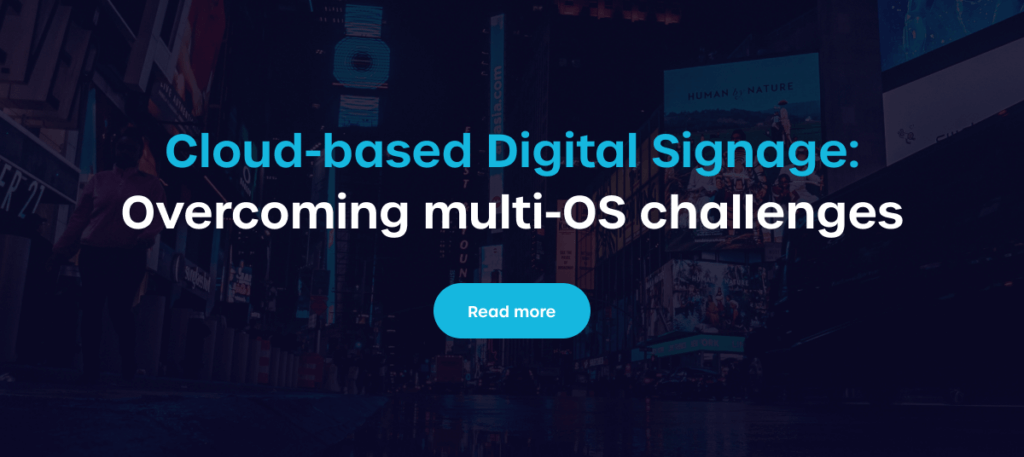Managing multiple screens in digital signage systems presents unique challenges that can impact the effectiveness and efficiency of a business’s communication strategy. From ensuring seamless content synchronization to handling diverse hardware environments, these obstacles require careful attention. Understanding these obstacles is essential for organizations looking to optimize their signage networks. In this article, we explore the top four challenges faced when managing integrated signage solutions.
Keeping content in sync across all screens
Maintaining synchronization of content across various screens is crucial in delivering a seamless audience experience. This can be particularly challenging when utilizing digital signage software for smart TV solutions that span multiple locations and devices.
Why timing matters in multi-screen environments
Precise timing is critical in multi-screen environments, where even slight delays between screens can break visual continuity. The human eye is surprisingly sensitive – research shows that we can detect visual desynchronization as small as 30 to 50 milliseconds, especially when content includes motion or transitions across screens. This level of perception is why misaligned video playback across displays can feel jarring, even if the delay seems minimal on paper.
The importance of timing becomes even more pronounced when audio is involved. Studies indicate that viewers start noticing lip-sync issues when audio leads video by more than 40–60 milliseconds, or when video leads audio by more than 80–100 milliseconds. These perceptual thresholds make it clear: whether you’re managing synchronized visuals or audiovisual content, milliseconds matter.
How to maintain consistent playback across devices
To ensure consistent content playback across multiple screens, it is crucial to use robust digital signage software that supports both smart TVs and a variety of other devices. In scenarios where video and audio need to be synchronized, visible delays may occur – such as between different system versions or devices running on different platforms.
Even a few milliseconds of discrepancy in the device’s clock can impact synchronization, which is why precision is essential for seamless operation. We have developed effective solutions that ensure perfect synchronization of both video and audio, eliminating noticeable differences for viewers.
Navigating hardware and platform diversity
Navigating the varied landscape of hardware and platform capabilities is crucial for effective digital signage software development. Choosing a versatile digital signage solution that accommodates a wide array of screens will enable businesses to deliver cohesive content across diverse platforms.
Different screens, different operating systems
Each screen in your digital signage network may operate on a different system, whether it’s Android, iOS, webOS, Tizen, or proprietary hardware. These differences can significantly impact content delivery. Each platform offers different APIs, performance capabilities, and playback behavior. Understanding and adapting to these differences can lead to noticeable improvements, such as smoother video playback or faster content rendering.
Here are the best practices that you can follow:
- Research display options before development – know your target platforms and their limitations.
- Use cross-platform solutions – choose tools that offer broad OS compatibility and flexibility.
- Implement ongoing testing for compatibility – regularly test across devices to catch performance or display issues early.
Adapting content for resolution, orientation, and screen capabilities
Digital signage displays vary in resolution, orientation, and capabilities, making it essential to design content that fits each screen’s unique setup. Without proper adjustments, visuals can appear stretched, cropped, or misaligned, reducing clarity and impact. Effective digital signage software should support dynamic layouts that adapt to different screen configurations automatically.
Responsive content ensures that messaging remains visually appealing and functional across all devices. By leveraging flexible templates and resolution-aware design, brands can deliver a consistent experience regardless of screen size or placement. This attention to detail enhances viewer engagement and reinforces professionalism.

Managing content at scale across locations
Effectively managing content across multiple locations requires a delicate balance between centralized control and local customization. Digital signage solutions must offer tools that facilitate this approach, enabling businesses to implement an integrated signage strategy.
Balancing centralized control with local customization
Centralized control allows for streamlined content management, ensuring brand messages stay consistent across all locations. However, local customization is equally important, enabling businesses to tailor content to specific audiences or regional needs. For example, screens can use geolocation or local weather data from the device to display relevant promotions - like advertising cold drinks on a hot day in one city, while showing umbrella offers in another.
An effective digital signage system incorporates features that allow for quick, local adjustments without compromising the overall brand strategy. This balance between consistency and personalization enhances engagement and drives better results.
Leveraging smart scheduling and automation in integrated signage
Smart scheduling and automation features greatly simplify managing content across multiple locations. Businesses can pre-schedule messages in the TV applications based on time, audience, or events to ensure that the right content reaches viewers at the perfect moment. To avoid issues caused by incorrect device settings or time zone changes, it’s recommended to use UTC or timestamps, ensuring consistent and reliable scheduling.
Additionally, content can be displayed according to a time zone defined in the CMS, rather than relying on the device’s local configuration. This approach not only prevents errors but also allows for greater personalization and centralized control. All content is then played automatically, regardless of the individual screen’s settings, making scheduling more flexible and robust.


Securing and maintaining an integrated signage system
An integrated digital signage system requires diligent security practices and maintenance protocols to function effectively. Regular updates and vigilant monitoring are essential to avoid potential threats and maintain a smooth user experience.
The importance of regular updates and system monitoring
Regular updates to digital signage software are essential for maintaining performance and addressing known issues.

Manufacturers like LG or Samsung often release patches that improve stability or fix vulnerabilities, so staying informed and applying updates is key.
In many cases, you can also communicate directly with the manufacturer, reporting specific issues so they can release targeted updates based on real-world usage.
However, not all signage platforms support simple update processes, so it’s important to research how updates are handled and choose a solution compatible with your setup. This proactive approach ensures your system remains secure, stable, and aligned with your business needs.
In addition, monitoring system health plays a key role in optimizing performance. Many signage devices have limited resources, so it's vital to track CPU and RAM usage to ensure your application isn’t overloading the hardware. Ongoing monitoring and optimization help keep the system stable and content delivery smooth, especially in long-term deployments.
Protecting the network from unauthorized access to integrated signage
An integrated signage network is exposed to potential threats such as unauthorized access, data interception, and remote tampering. To maintain system integrity and protect sensitive content, it's crucial to implement a layered security approach that addresses both infrastructure and communication vulnerabilities.
Key security practices include:
- Using VPNs to isolate the signage network from public access
- Configuring firewalls to control and restrict incoming/outgoing traffic
- Implementing end-to-end encryption for data transmission between CMS and devices
- Enforcing user authentication and access control for system administrators
- Regularly updating software to patch known vulnerabilities
These measures help ensure the reliability of your signage system, reduce the risk of attacks, and strengthen trust in your digital communications.

Integrated signage - FAQ
What is integrated signage, and why is it useful?
Integrated signage refers to a comprehensive system that synchronizes content across various display devices. It is useful because it offers a unified platform for managing digital signage content, ensuring consistency and enhancing viewer engagement. This system allows for dynamic content adjustments based on real-time data, furthering its utility in different environments.
Can all types of screens be used in an integrated signage system?
Most types of screens can indeed be used within an integrated signage system, provided that they are compatible with the digital signage software utilized. However, it’s vital to consider resolution, operating systems, and display technologies when integrating various screens. Using versatile digital signage solutions will ensure broader compatibility and seamless functionality.
What are the most important features of a secure integrated signage network?
A secure integrated signage network must be designed to protect against unauthorized access, data breaches, and system disruptions. Key features that ensure security include:
- VPN integration – keeps the network isolated from public internet access, reducing exposure to external threats.
- Firewalls – control traffic flow to and from signage devices, preventing unauthorized connections.
- Encrypted communication – ensures all data transmitted between the CMS and displays is protected from interception.
- User authentication and role-based access control – prevents unauthorized users from accessing or modifying content and system settings.
- Regular software updates – patches vulnerabilities and keeps the system aligned with current security standards.
- Monitoring and logging – helps detect unusual activity and supports fast response to potential security incidents.
By combining these elements, businesses can maintain the integrity of their signage network, protect sensitive content, and build trust with their audience.






